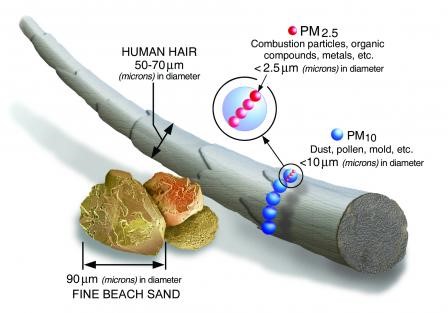We are led to believe that PM2.5 particulate matter from coal-fired power plants will lead to 11,000 (or pick a number) premature deaths, as part of various permitting disputes!
Here’s one:
“The original rule required power plants to reduce emissions of mercury and other toxic pollutants by more than 90 percent over five years. Mercury is a neurotoxin that can damage the brain and nervous system in young children, leading to lower I.Q. and impaired motor skills. The Obama administration estimated that the measure would prevent 4,700 heart attacks and 130,000 asthma attacks as well as 11,000 premature deaths by also eliminating fine particulate matter linked to those ailments.”
This is what PM2.5 particles look like:


I’ve often wondered, just how does one go about making such premature death rate projection?
If asked, here’s what I would do. I expect the analysts do something similar.
We have measured and reported primary data on the particulate levels for ⁓50 geographic areas in the U.S.
I also assume we also have primary death and death rates that generally indicate the cause of death. It would be unrealistic to expect that the actual cause of death could or would be identified specifically as PM2.5 particle, or even a bunch of PM2.5 particles, so these must be some sort of average rates.
These death rates can be compared across geographies to search for and explore anomalies. A premature death rate can be determined, based on comparative averages. I suppose that If one dies before the “average age”, within some range, it could be defined as “premature”.
The particulate level measured in any specific location, however, is not differentiated by source. The data can only be the mixed average of all particulate matter sources in that area. Sensors would not be able to differentiate PM2.5 particulate by source and, of course, that means that power plant emissions are lumped together with diesel exhaust, among others.
I expect that that these undifferentiated particulate measures are then compared to “premature” death rates to render a statistical relationship between the two.
That lead me to ask, “what are the sources of PM2.5 particles?”
The National Emissions Inventory (NEI) is a comprehensive and detailed estimate of air emissions of criteria pollutants, criteria precursors, and hazardous air pollutants from air emissions sources. The NEI is released every three years based primarily upon data provided by State, Local, and Tribal air agencies for sources in their jurisdictions and supplemented by data developed by the US EPA. The NEI is built using the Emissions Inventory System (EIS) first to collect the data from State, Local, and Tribal air agencies and then to blend that data with other data sources.
Here is their most recent data:

Fuel Combustion by Electric Utilities accounts for less than 3% of the PM2.5 emissions.
Call me “old fashioned”, but I am thinking that maybe we should go after the “Wildfires” and the “Miscellaneous”, which account for 75% of the PM2.5 problem, and quit picking on electric utilities!
